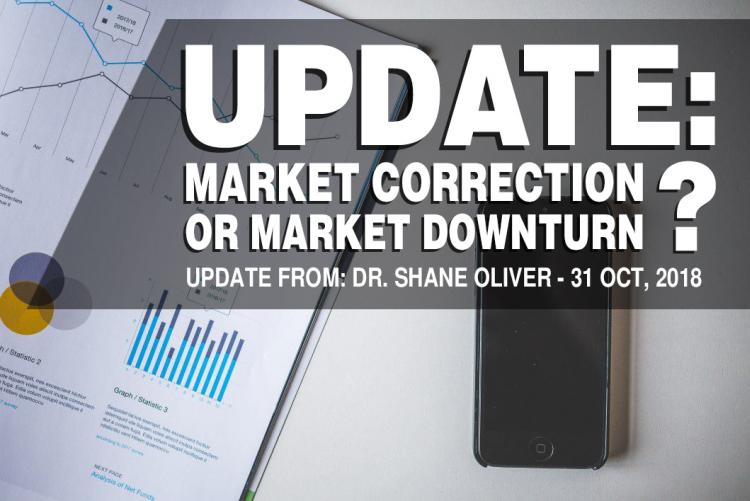It’s understandable that the recent sharp sell-off on financial markets has left investors feeling particularly nervous. The main concern has been the US Federal Reserve’s shift in monetary policy from low rates and printing money to rising rates and the withdrawal of that printing policy.
But there’s also a lengthy worry list of issues that we hear continuously: the US trade conflict with China, issues around the leadership of President Donald Trump, and the economic and budgetary implications of the populist government in Italy.
At the same time, we’ve had a lot of high-profile global investment commentators warning of some sort of crash or bear market some time down the track.
Additionally, there is always fear around September and October, the months when the 1987 stock market crash and the worst of the Global Financial Crisis occurred. These months are known for volatility.
After several years of good returns, all of this has created a degree of nervousness.
With markets a bit more stable this week, and prices having bounced, it’s a good time to take a pause and reflect on where things are at. But to particularly address the main question investors have: is this the start of a bear market or just another correction? And what does that mean for their portfolios?
So far, a correction
The sell-off has seen most developed equity markets fall around 7%. As of the most recent low on October 15, the Australian market was down 4.5% in October, but down 8% from its late August peak. Emerging markets have posted bigger falls of, on average, nearly 20%.
These levels of falls are technically a correction. As I noted in my last Oliver’s Insights, we often go through periods of volatility where markets have set backs. You have a rising trend, but every so often you get a pullback of roughly 10%. The bulk of those pullbacks don’t go on to become major bear markets. (Many investors might have forgotten that we came into this year and had a pullback in January/March initially driven by US inflation and interest rate worries.)
Could it turn into a bear market?
But while corrections are normal, investors are right to ask whether this one is different. Is this sell-off the one that does represent the start of a major bear market?
History tells us that major bear markets come along when there is a US recession. The big bear markets of the mid-70s, early-80s, early-2000s (the tech wreck), and the GFC were all associated with a US recession.
To get a ‘grizzly’ bear market that really worries people – where prices fall 20% one year and then another 20% the following year – as opposed to a ‘gummy’ bear market – where markets fall say 20% and it feels horrible, but a year later you’re up again – you really need evidence that the US is going into a recession.
The question investors need to ask themselves is, ‘do you think the US, Australia and the rest of the world is going into recession?’. If the answer is yes, then you’d be a lot more cautious.
But if the US isn’t about to go into recession, and earnings continue to grow and interest rates remain relatively low, the odds are that this turns out to be just another correction, which we see a lot of.
A US recession is unlikely
My view is that a US recession is still some way away and for now it’s unlikely. A lot of the things you normally look for as a guide to whether the US is going into recession are just not there. We haven’t seen the same degree of over-investment, wages growth is still relatively benign, and the US Federal Reserve is still a long way from adopting tight monetary policy.
One of the big worries for investors has been rising interest rates. But interest rates are rising because economic conditions are good. That’s something we have been hoping for for almost a decade: that things would go back to normal. The US Federal Reserve is only raising interest rates because the emergency is over, and the US economy can come off the medicine.
Of course, at some point a recession will inevitably happen, even though in Australia we have managed to avoid one for a long time. But in the US, it’s probably still at least 18 months away. If I thought a US recession was six to 12 months away, I would be a lot more nervous. But we’re not there yet. The normal circumstances that precede a US recession just aren’t evident, and they’re not evident in Australia either.
Take a long-term view
The thing to do now is to take a long-term view and recognise that corrections and sell-offs are not the times to move to cash but are actually opportunities for many investors, particularly if you are young and still contributing to the market.
For most investors who have long term investment horizons, corrections are good because it means when you’re averaging in, as you do via super, you’re buying in at a lower level.
For example, I was actually better off after the infamous 1987 crash, when the Australian market fell 50%, because for the five or six years the market took to recover I was buying shares at a lower price than I otherwise would have been able to. I benefited from the 50% plunge that occurred because I was contributing to the market via my super through that period.
The worst thing I could have done back then would have been to say, ‘this is horrible, I’ve seen a big chunk of wealth eliminated so I’ll switch to cash and bonds’. I would have done ok for a while because interest rates were much higher then. But if I’d stayed in cash forever after 1987, my super would be a lot lower than it is today.
Corrections are more of a problem for retirees and people close to retirement because they don’t have the opportunity to buy into the market unless they have cash sitting around.
But even though the market has fallen 8%, dividends didn’t fall 8%. In fact, the dividend income flow has continued. If you are a retiree and it’s income you want, you are still getting that income through the volatility. If anything, for those who can buy in now, that income as measured as a yield became more attractive than it was before the market fall.
So it really does depend on the type of investor you are. For young people I don’t think you should be worried about this volatility at all, in fact it could be viewed as a good thing. The current market conditions are mainly an issue for self-funded retirees and people close to retirement. If you’re in that group it’s a function of trying to work out what’s most important to you: is it the income flow you receive, or is it the capital value of your investment? For most, it’s probably some combination of the two which means you need two strategies. But it’s not catastrophic, providing you can keep your head.
Looking for opportunity
After the recent sell-off, shares are suddenly cheaper than before. The forward price-to-earnings ratio on our market was around 15 times and has now fallen back to around 14 times. That is not a dramatic fall – nothing in the order of that which was seen in the GFC – but there is an opportunity to the extent that the market is now cheaper.
There are also opportunities in some sectors. Tech stocks, healthcare, financials, and industrials have been among the hardest hit. But there is value in some of them. The dividend yield for banks is still quite high. For investors looking for good income flow, the banks are delivering franked dividend yields of around 8% or more. Energy stocks are also down 4.5% month-to-date at a time when it’s likely oil prices are going to rise.
During a sell-off, investors tend to sell things willy nilly. The trick for investors through these periods is to try and find value rather than to get too hung up on the fact that the market is coming down.
Where to from now?
We have moved into earnings season for the September quarter and the market is getting confirmation that US earnings are still strong, which has provided a degree of support for markets.
Of course, markets could still come down again and show more weakness before we bottom out. We can’t know when that bottom will occur with any certainty. All I do know is that, at this stage, the risk of a major ‘grizzly’ bear market, while impossible to rule out, is relatively low.
Back in 2008, at the height of the GFC, famous US investor Warren Buffett, who was buying beaten-up financial stocks like Goldman Sachs, said he didn’t know when the markets would bottom. But what he did say is that the companies he was investing in will most likely be around in the years ahead and that the US economy would recover.
In the current correction, it’s wise to take that approach. Instead of focussing on a short-term, day-to-day horizon and leaving all your funds in cash, have the confidence to focus on the long-term trend, and to look for opportunities the correction has created.
Source: ampcapital.com/au/en/insights-hub/articles/2018/October/Market-correction-or-market-turn

